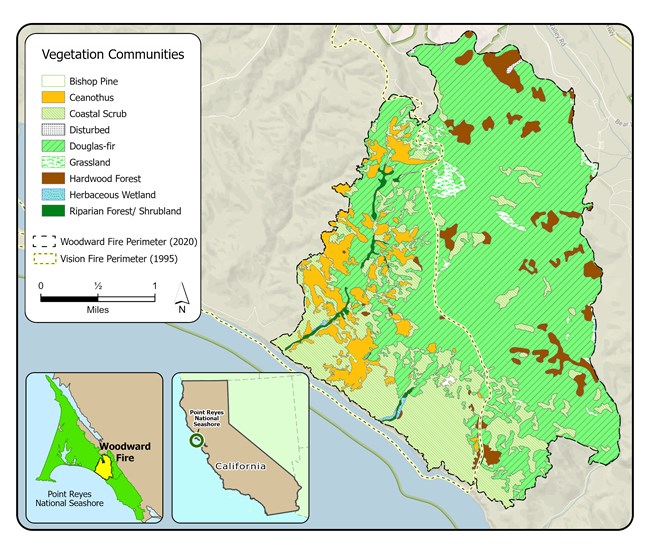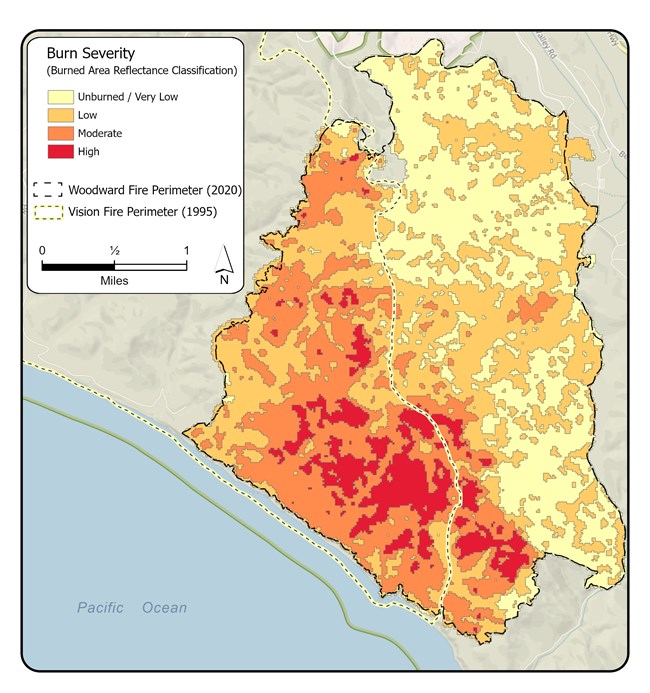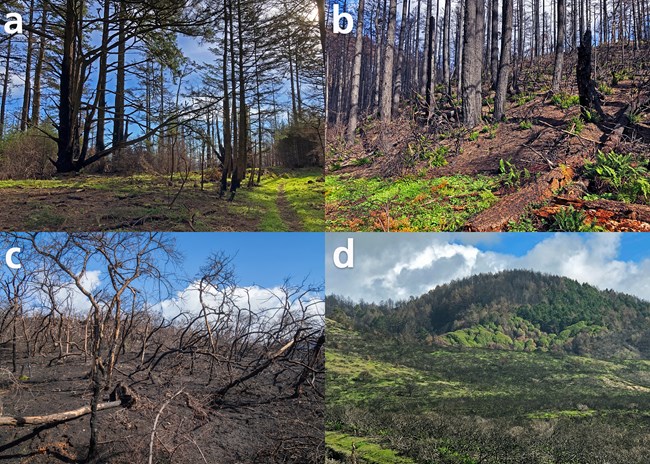Last updated: January 28, 2024
Article
Reflections on the 2020 Woodward Fire: Understanding the Impacts of Fire on Point Reyes Ecosystems

NPS
August 2021 - 2020 was a record-breaking year for California wildfires. As Fall 2021 arrives, what did land managers learn from last year? What was it like to make decisions on the ground as wildfire burned through the landscape? And did all of the 2020 fires fit the prevailing narrative of unprecedented destruction?
The Woodward Fire, which ignited in August 2020 and burned nearly 5,000 acres of Point Reyes National Seashore wilderness, provides valuable counterpoint to the ecological devastation seen from many of other 2020 California fires. This landscape used to burn frequently under the stewardship of native peoples. In fact, many plants at Point Reyes tolerate or require fire to regenerate. The fire did not cause significant damage to human safety or structures. It presents a unique opportunity to observe the effects of a mixed-severity fire on an ecologically rich patchwork of coastal California habitats.
Fire in a complex ecological context: Point Reyes fire regimes, then and now
Point Reyes hosts astounding ecological diversity due to its unique climate, geology, and hydrology. The varied fire history of the region also adds ecological complexity. Native peoples of California used fire annually to to improve seed harvests and keep scrub and tree species from encroaching onto grasslands. But these frequent burns ceased almost entirely as land-use strategies shifted in the early to middle 20th century. Still, many of the native plant species of Point Reye are adapted to tolerate or even require fire to persist. Several species of native chaparral scrub found at Point Reyes, including some manzanita and Ceanothus species, are obligate seeders: their seeds only germinate after exposure to heat or smoke from a wildfire. Periodic fire in these areas could have ecological benefits, including regenerating fire-following species, maintaining California native grassland habitats, and reducing surface fuels.
However, the park's proximity to homes and urban development limits the use of fire as a management tool. The Woodward Fire poses a unique opportunity to better understand the impacts of fire in a region where it has been relatively infrequent since Native American burning.
Sparked by an unusual lightning storm
The Woodward fire was one of many fires sparked by unusual lightning storms that swept through across California in August 2020. Temperatures were high, vegetation was dry, and at Point Reyes, the unusual weather pattern disrupted the fog (which is usually heavy in the summer) and shifted wind patterns. Because fires were burning all across the state, firefighting resources were stretched thin. Local firefighters worked to control the Woodward Fire, but it grew quickly. Based on the lack of available firefighting resources, the proximity of the fire to the neighboring communities, and the fact that the fire was burning through designated wilderness and sensitive natural and cultural resources, a Type I incident management team took over management of the Woodward Fire. This type of firefighting team is dispatched from the National Interagency Fire Center and includes highly-trained staff with a range of expertise from federal, state, local, and tribal entities.
Park staff collaborated with the firefighting team as they worked to control the fire, using strategic approaches to protect structures and to mitigate damage to the landscape from the firefighting operations themselves. After the initial period of rapid spread, much of the remaining growth of the fire occurred during burn-out operations, where firefighters set back fires from established containment lines. Evacuation orders and warnings for surrounding communities were lifted in early September, and the fire was declared contained on September 30 at 4,929 acres. Intermittent flare-ups and smoldering continued in the interior area of the fire until January 2021.

NPS
How are park ecologists tracking the effects of fire on the landscape, and what have they observed so far?
Park staff used remote sensing data to assess the severity of fire damage to vegetated areas. Most of the area of the Woodward Fire burned with low or moderate severity (See burn severity map). The majority (67%) of the fire area was mapped as “unburned or low severity,” 25% was “moderate severity,” and only 8% was “high severity.” Most of the areas that burned with the highest severity occurred in the early days of the fire when it was spreading rapidly, primarily in habitat characterized by coastal scrub or Ceanothus thyrsiflorus (285 acres) and Douglas-fir (135 acres). Ceanothus thyrsiflorus is relatively well adapted to high-severity fire and is expected to regenerate quickly. The Douglas-fir areas, however, experienced significant damage to the forest canopy. Based on similar areas that burned in the 1995 Vision Fire, some of these areas may eventually regenerate as new Douglas-fir forests, but the fire may cause shifts to coastal scrub or perhaps even trigger germination of a previously dormant seedbank of chaparral species such as C. thyrsiflorus or manzanita.

NPS / Alison Forrestel (a, b, and d) and Maritte O'Gallagher (c)
Potential wildlife impacts
The most significant wildlife impacts also likely occurred in the high-severity burn areas. It is likely that the 1995 Vision Fire wiped out a significant portion of the Point Reyes mountain beaver. Mountain beaver distribution, populations, and ecology are not well understood, but it is likely that additional mortality occurred in the Woodward Fire. Because fire uncovers previously undetectable burrows, biologists have begun monitoring of the Point Reyes Mountain Beaver post-Woodward Fire in an effort to better understand the population.
The Woodward Fire also burned through several northern spotted owl territories. There were no known direct effects of the fire on individual spotted owls, with the fire occurring outside of nesting season and burning with low or moderate severity in owl habitat. But the long-term and indirect effects of the fire on northern spotted owls remain to be seen. Biologists will continue routine monitoring of Northern spotted owls post fire, and expand the program to collaborate in a multi-agency comprehensive population study for northern spotted owls to conduct acoustic monitoring throughout the burn footprint and other areas of the species’ habitat in the region.
A large portion of the fire burned with low or moderate severity, particularly after the initial days of rapid spread and during burn-out operations. In these low-severity burn areas, fire crept through the ground cover with very little damage to the secondary canopy (primarily oaks and bay trees) and almost no impact to the upper canopy (primarily Douglas-fir). These areas will remain shaded enough to provide valuable moisture retention and cover for wildlife, but the fire effectively reduced understory and surface fuels. Re-growth is already beginning, with ferns and huckleberry re-sprouting. Because cover is still present in these areas and signs of regeneration are apparent, ecologists do not expect significant shifts in vegetation or wildlife activity in low-severity burn areas.
Role of fire suppression
In addition to the direct effects of the fire on the landscape, fire suppression efforts also had a large role in the overall ecological impact of the Woodward Fire. The policy at Point Reyes National Seashore is to suppress all unplanned ignitions due to the relatively small size of the park and the close proximity of homes and infrastructure. The Woodward Fire was burning within a few miles of the communities of Olema and Inverness Park, as well as neighborhoods on Inverness Ridge that were previously impacted by the Vision Fire. Because of this park policy and the location of the Woodward Fire, the fire was actively suppressed, in spite of the wilderness location and potential for ecological benefits. As part of the suppression efforts, 8.5 miles of bulldozer line were constructed, much in designated wilderness, 7.5 miles of handline were constructed, and more than 50,000 gallons of fire retardant were dropped across the landscape. Park ecologists and resource advisors worked closely with the incident management teams to minimize the ecological impacts of these suppression actions. Bulldozer lines were kept to the minimum effective width (generally this was two blades wide; approximately 15-20 feet) and were located, when possible, in the same locations as bulldozer lines that had been installed as part of the Vision Fire suppression effort. The team avoided fire retardant drops over riparian (stream adjacent) areas in order to prevent harm to aquatic species. Resource advisors worked with incident management staff to avoid the spread of invasive species and impacts to rare species. Although park staff carefully rehabilitated bulldozer lines and handlines after the fire, long-term efforts to control invasive plant species in the fire footprint will be required. The spread of invasive species post-fire is of particular concern, especially around bulldozer lines, retardant drop sites, and in areas that burned with higher severity. Invasive plant species within the burn area before the fire include jubata grass, panic veldt grass, and ox-eye daisy. Park staff have already initiated monitoring plans for post-fire recovery and invasive plant management.
Reflecting on a unique opportunity to understand the impacts of fire at Point Reyes
The Woodward Fire presented an opportunity to return the important ecological process of fire to the Point Reyes landscape—something that would have been very challenging to accomplish at the same scale using prescribed burning given the extensive wildland-urban interface surrounding the park.
Based on the effects observed following the 1995 Vision Fire, the careful management of suppression impacts, and the overall mixed severity of the Woodward Fire, ecologists expect most of the vegetation communities burned in the Woodward Fire to regenerate well. Due to the rich ecology and complex fire history within the burn area, ecologists anticipate that various habitat types will recover from the fire differently, resulting in a more diverse network of habitats on the landscape. Post-fire re-growth will likely include shifts in vegetation types and the possible appearance of rare fire-following species (such as Arctostaphylos virgata, Ceanothus masonii, or Crocanthemum scoparium) as well as reduced fuel loading.
However, the full ecological effects of the fire remain unknown. Many factors affect how the area will recover, including weather for the next few seasons, availability of seed sources, and impacts of invasive species. In particular, the 2021 water year was unusually dry, with Marin County receiving less than 40% of average rainfall. This may negatively affect vegetation regeneration. In addition, major disturbances like wildfires can themselves cause climate-related shifts. Park staff are monitoring to see whether detrimental changes occur. They'll look for vegetation failing to regenerate, a loss of sensitive species or habitats, or a shift towards non-native invasive species.
With the complexities of climate change, longer fire seasons, and more frequent and larger fires on the horizon, learnings from the Woodward Fire have inspired managers to reconsider the role of fire. Can it be used safely to steward some of California’s last remaining native coastal habitats? The challenge remains of balancing the potential ecological benefits of fire with the political realities of managing wildlands close to residential communities and urban development.
- Read the full publication: O’Gallagher, Maritte J., Jones, Gregory A., Parsons, Lorraine S., Press, Dave T., Rehlaender, Wende E., Skartvedt, Stephen, Forrestel, Alison B. 2021. 2020 Woodward Fire case study: Examining the role of fire as an ecological process in a coastal California ecosystem. Parks Stewardship Forum, 37:2. http://dx.doi.org/10.5070/P537253239
- Questions? Contact Maritte O'Gallagher or Alison Forrestel.
